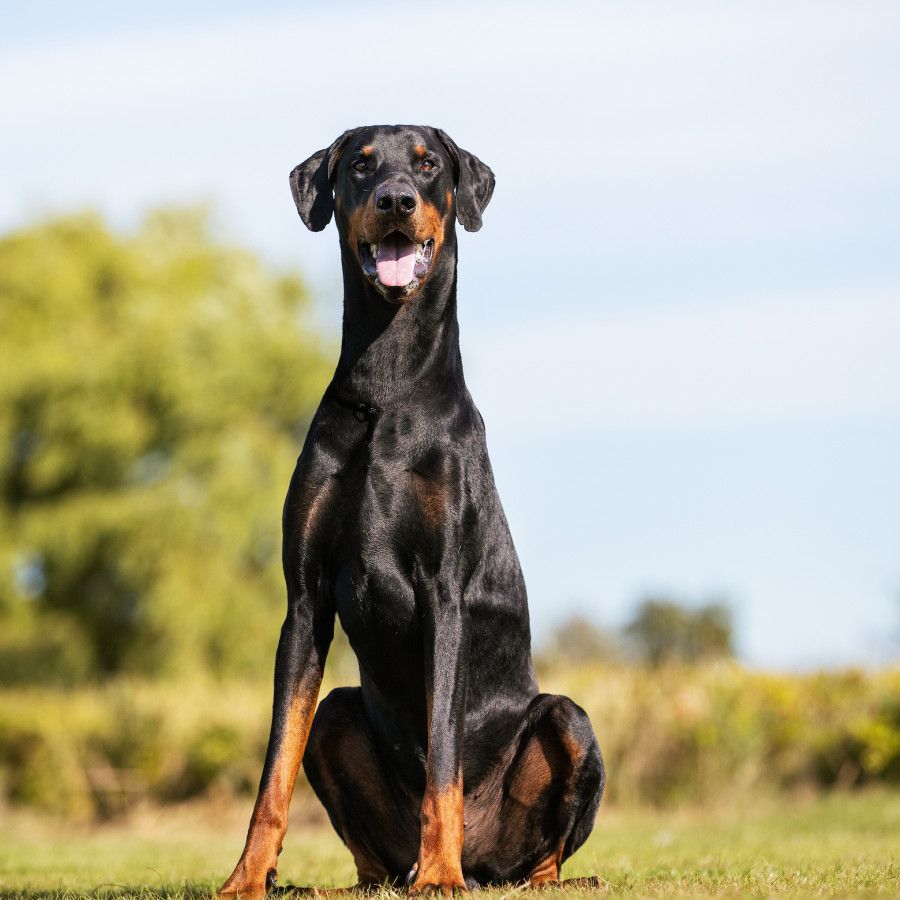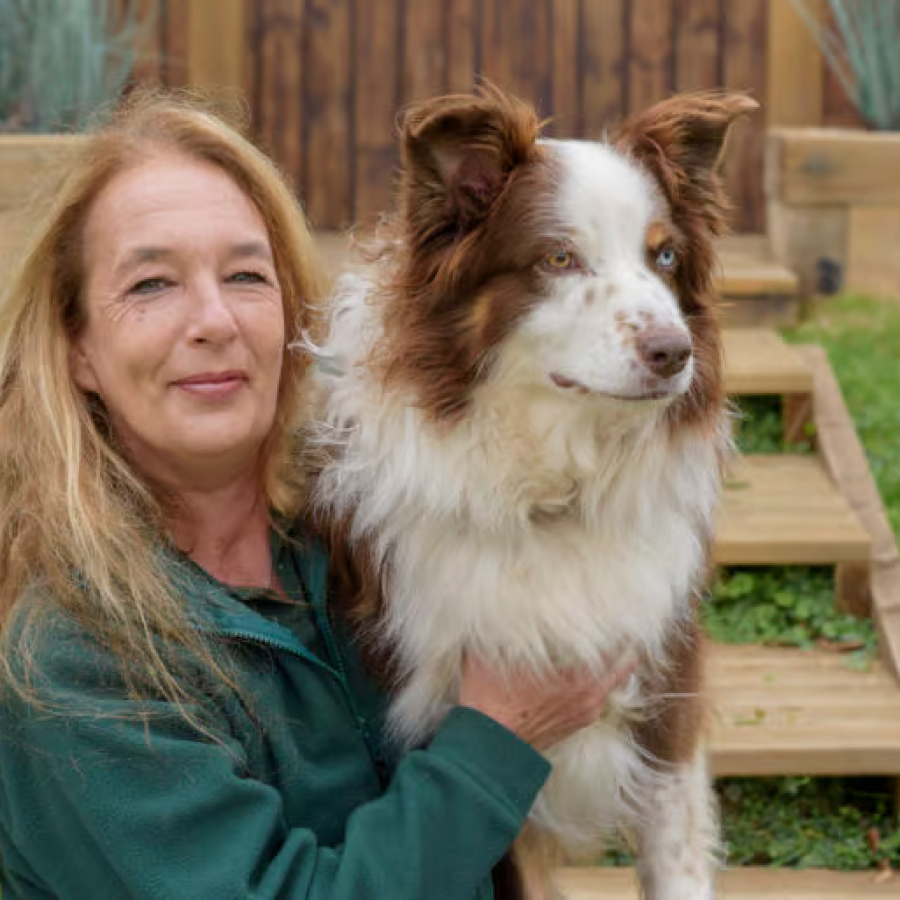
Dobermann Dog Breed
Dobermanns are lively, clever dogs with a goofy side. They love a snuggle!

Dobermanns are lively, clever dogs with a goofy side. They love a snuggle!
The Dobermann is a highly intelligent working breed that forms strong bonds with its family.
Their trainability and physical capabilities have led the breed to have a rich history of working closely with humans in the police and army for many generations.
More recently, they’ve become more popular as pet dogs and, given the right guidance and exercise, make goofy and loyal companions.
Dobermanns are generally high-energy dogs and are very trainable.
They worked alongside humans for centuries and need energetic daily exercise to keep them happy as pets. This breed is powerful and so they need the right training to avoid them causing havoc.
Dobermanns were bred as protection dogs for tax collectors in the 19th century. So, they can be reserved around strangers and need to learn the right way to be around people and other animals when they’re young (this is called socialisation).
They’re very playful and are happiest when they can spend some quality time goofing around with their favourite people.
As they form strong bonds with their families, they can be needy and have issues with being away from their people. They’re even nicknamed “Velcro dogs” as they rarely want to leave their owner’s side.
Disclaimer
While these breed traits give a general idea of what to expect from a specific type of dog, it's important to remember that every dog is unique. Just like people, each dog comes with their own distinct personality, quirks, and characteristics!

A Dobermann can be a great choice for an active family if the dog is taught how to be around people, especially children, from an early age.
Training this big, strong dog is important so they have manners and self-control. Otherwise, they could easily knock over or injure small children. Like with all dogs, you should keep a close eye on them with children to prevent any accidents or inappropriate interactions.
Managing a young Dobermann around young children might be demanding at first, but the effort will pay off once your Dobermann is mature. These sweet dogs tend to be gentle around their family.
If you have a busy household with lots of visitors, you need to be aware that this breed is naturally protective of property and its people. To keep everyone safe, it may be wise to install baby gates to ensure your Doberman cannot have access to unfamiliar visitors to the home.
There are two varieties of Dobermann:
European Dobermann
This variety is slightly larger and squarer than the American type. They’re highly driven working dogs so might not be the best suited for family life.
American Dobermann
This smaller variety stems mainly from show Dobermanns and is generally said to be calmer.
Dobermanns would be most at home with active owners who can give them the training they need. This includes owners interested in dog sports and those who enjoy long and adventurous walks.
This active breed needs a large garden to burn off some of its bouncy energy and isn’t best suited to apartment life.
They aren’t always comfortable with strangers, so they would be better off living in a rural or semi-rural environment rather than a busy city centre.
Because they need lots of company and exercise, they aren’t the right breed for those who always work out of the house and need their dog to spend lots of time alone.
In general, Dobermanns can happily share their home with another dog, especially if they’re raised together from a young age and are opposite sexes.
They can live with other pets, too. But ideally, they need to be introduced to each other from a young age.
Like any dog, it’s important to help Dobermanns learn to be around people and animals in the right way from the start.
Dobermanns have plenty of energy to burn. Daily walks, training, and fun playtimes are a must!
They’re an incredibly fit and agile breed, having worked with the police force and army, and trained in dog sports and trials. They need to be given lots of exercise and training, otherwise, they might become hard to manage, over-the-top excited, or even frustrated.
Dobermanns can run extremely fast and need open space to hit full speed. An enclosed, secure dog field is perfect for this, so it’s worth researching what’s available near you. They also love to use their nose and enjoy tracks and obstacles set out by their owner with treats to find.
All puppies need to learn how to be around people, pets, and other dogs, calmly and politely (known as socialisation). They also need help to feel calm, comfortable, and confident in everyday situations like travelling, the sound of traffic, and being in busy places (known as habituation). This is essential to prevent tricky behavioural problems in the future, and you'll be off to a great start with your ongoing training.
Dobermanns are bright and pick up new things quite quickly. But always use kind, fair and effective reward-based training methods. Dobermanns get very attached to their handler and are sensitive to hard training methods and being scolded. It can make them anxious and unhappy.
It’s important to help them get used to people, dogs, traffic and all the sights, sounds and smells they will encounter in daily life. If this is missed, they can become reactive or aggressive.
As this breed is powerful and energetic, owners need to spend time training and managing them so they’re safe in public and at home. Anyone training them needs a good understanding of dog training and should feel confident in their skills.
You can gradually build their confidence to be away from their owners and spend time at home alone. This is an important step in making sure they don’t develop problems with you being away.
Clear communication, boundaries and a positive relationship are important. This helps your Dobermann avoid attention-seeking behaviours in the home such as nuisance barking, stealing items and becoming destructive.
Dobermanns have a short coat and don’t shed lots. But, like most breeds, they do shed more in the spring and fall.
Brush your Dobermann once a week with a rubber grooming mitt or bristle brush. Brushing helps distribute the natural oils in their coat and removes dead hair.
You can give your Dobermann a bath, but not too often. A good rule of thumb is once every two months.
These dogs also need their ears cleaned regularly as they’re prone to ear infections. Historically, Dobermanns were subjected to the cruel practice of ear cropping, and their tail was docked to give them a more fearsome appearance. Thankfully, this practice is now illegal in many countries, and we’re seeing more Dobermanns with lovely floppy ears and long tails, as it should be.
Dobermanns can be prone to several diseases. If you buy from a breeder, it’s wise to make sure their parents are health tested and aren’t carriers of certain diseases.
Here are some conditions found in Dobermanns:
Von Willebrand’s disease: A disorder where the blood doesn’t clot properly. There’s no cure for this disease, but it’s important to know whether your dog has it in case they get injured or need surgery.
Dilated cardiomyopathy: A disease that stops the heart muscle from pumping blood well. The outlook isn’t always good as sometimes symptoms show up too late.
Head tremors: Also called Head Bobbing Syndrome, the dog will sometimes have a shaking head and/or chattering teeth. Experts don’t know exactly why this happens, but it’s usually not harmful.
Intervertebral disc disease: A disease that affects the spinal cord and causes mobility issues and pain, which gets worse over time.
As with all large breeds, Dobermanns have an increased risk of gastric torsion (which affects their digestive system), hip or elbow dysplasia (a joint problem), arthritis, and an underactive thyroid.
I need lots of exercise and adventure. Two hours of good, energetic movement and lots of play sessions will keep me happy. I’ve been bred to be very trainable and need to understand what’s expected of me.
I’m one of the favourite breeds for dog sports competitions. I love working my brain and will need regular training and problem-solving opportunities, otherwise I become frustrated.
I’m an all-rounder! I’d enjoy and excel at most dog sports, particularly tracking and Schutzhund training (a working trial). If I don’t do any dog sports, my family must give me lots of opportunities to use my brain.
Take our quiz to discover which breed is right for you
Take our quizPlease call our pet support line on 0300 303 9333 (7 days a week – 8.30am - 4pm)